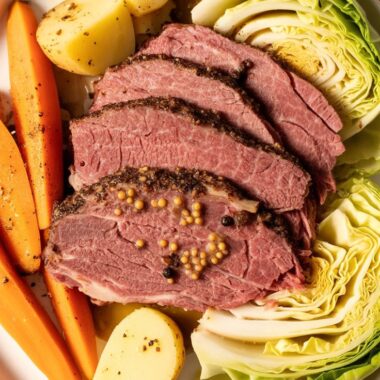If there’s one eggplant dish I keep on repeat at home, it’s this Thai Basil Eggplant. Tender slices of Japanese eggplant tossed in a bold, sweet-salty sauce with fresh Thai basil—it’s the kind of weeknight meal that feels restaurant-worthy without the hassle.
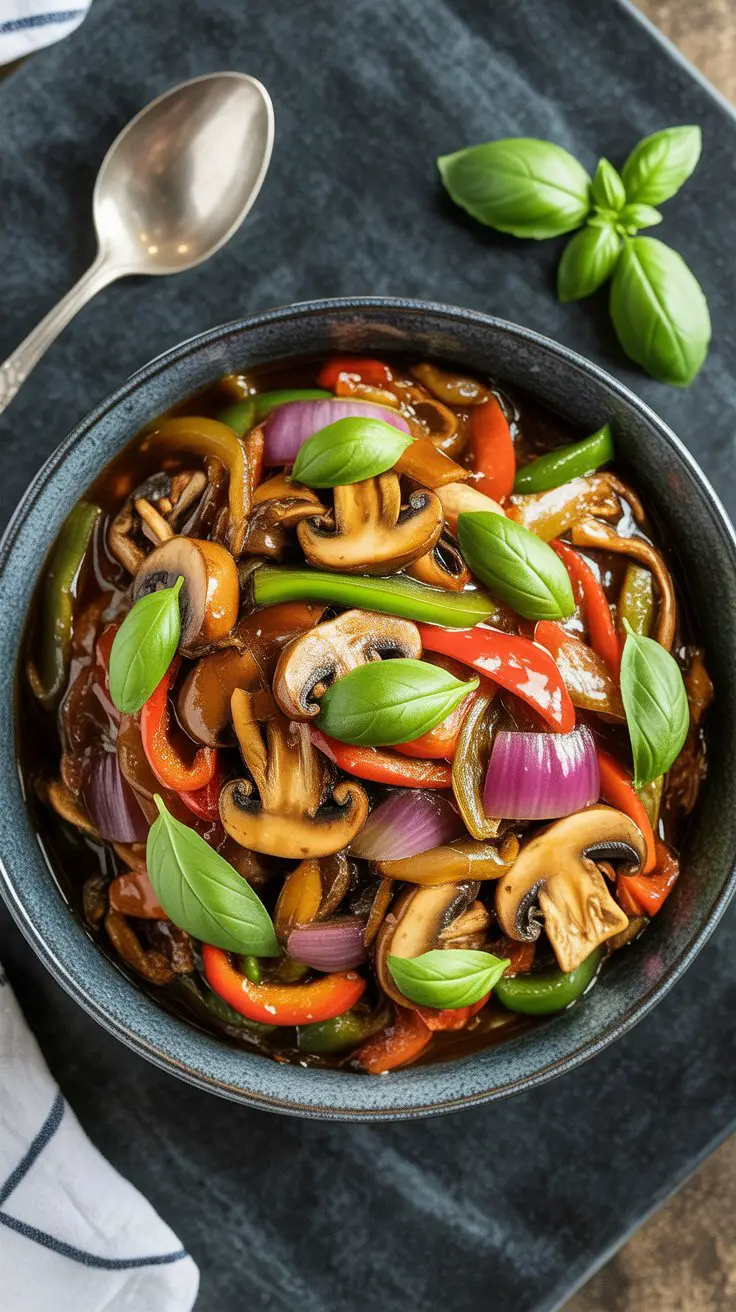
It’s naturally vegan, gluten-free, and incredibly satisfying whether you pair it with jasmine rice, brown rice, or even some quick noodles. And the best part? You can pull it together in about 30 minutes—pan, cutting board, and one blender is all you need.
Why This Dish Is Always a Hit in My Kitchen
I grew up loving eggplant—whether it was smoky baingan bharta or crispy eggplant fries my mom made on weekends. But once I tried Thai-style eggplant at a local restaurant, I knew I had to recreate it at home.
This version hits all the right notes:
- Just the right amount of chew from pan-fried eggplant
- That glossy, garlicky sauce with sweet and savory layers
- The punch of Thai basil that makes it unmistakably Thai
Even folks in my house who usually skip eggplant help themselves to second servings of this. It’s that kind of dish—converts even the skeptics.
What You’ll Need (And What Not to Swap)
Japanese Eggplant
Please don’t swap this out if you can help it. Japanese eggplants have a thin skin and a soft, creamy interior that soaks up flavor beautifully without turning to mush. The texture is spot-on for this dish.
Thai Basil
This one’s a must. Sweet basil just doesn’t give you the same sharp, peppery kick. Thai basil has a slight anise flavor that pairs so well with the sauce—it’s worth the extra effort to find it.
Bell Peppers & Onion
I toss in red bell pepper and onion for crunch and color. They also help balance the richness of the eggplant.
About That Sauce: A Make-at-Home Hoisin Swap
I rarely keep hoisin sauce in my fridge, so I pulled together my own little blend that hits the same sweet-savory notes. It has:
- Maple syrup for that mellow sweetness
- Tamari (or low-sodium soy sauce) for salt
- Rice vinegar to brighten it up
- A spoonful of peanut butter for body (you won’t taste it!)
- Sriracha for heat
- Toasted sesame oil for depth
- A pinch each of coriander and cinnamon (trust me on this)
Everything gets blended with a splash of water until smooth. It’s the kind of sauce that clings to veggies and makes you want to lick the bowl clean.
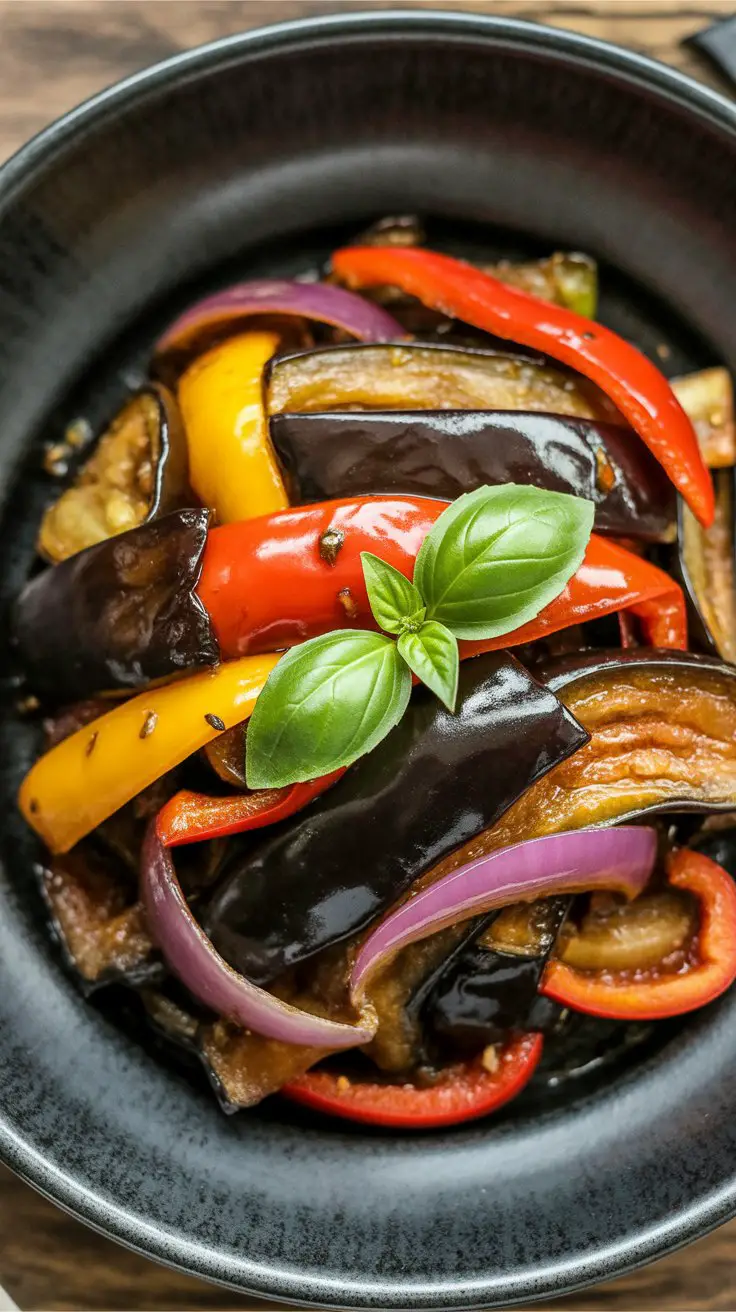
Step-by-Step: How I Make It at Home
1. Get Prepped
Slice the eggplant into half-moons—try not to go too thin or too thick. Do the same with the bell pepper and onion. I usually get all this done before I even heat the pan.
2. Make the Sauce
Toss all your sauce ingredients into a blender or small food processor. Blend until it looks smooth and well mixed. Stir together a quick cornstarch slurry too—this will help thicken the sauce later.
3. Stir-Fry the Veggies
In a hot pan with a bit of oil, sauté the peppers and onions quickly over high heat—just 1 to 2 minutes. They should stay a little crunchy. Scoop them out and set aside.
4. Cook the Eggplant
Add more oil to the same pan and cook the eggplant slices in a single layer. If your pan’s on the smaller side, do it in two batches. Stir often and sprinkle a little water as needed to help soften the eggplant without making it soggy. It usually takes me 7–8 minutes to get them perfectly tender with a bit of bite.
5. Build the Sauce
In the same (or a fresh) pan, sauté minced garlic, ginger, and a green chili until fragrant—about 1–2 minutes.
Pour in the blended sauce and the cornstarch slurry (give it a quick stir before pouring, as cornstarch tends to settle). Bring it to a simmer and let it thicken—this happens fast.
6. Toss Everything Together
Add the cooked eggplant, peppers, onions, and Thai basil. Stir gently to coat everything with that glossy sauce. Let it bubble for a minute or two, then turn off the heat.
How I Serve It
I love piling this Thai basil eggplant over warm brown rice—it soaks up the sauce beautifully. But jasmine rice, sticky rice, or even a bowl of soba noodles would be just as good.
If I’m feeling fancy, I’ll top it with extra basil or some crushed peanuts for crunch.
Cooking Tips from My Kitchen
- Don’t rush the eggplant. Let it soften slowly and evenly. Rushing it leads to burnt outsides and raw centers.
- Use a good non-stick or well-seasoned pan. Eggplant loves to stick.
- Sprinkle water, don’t pour. You want steam—not a soggy skillet.
- Prep your ingredients first. This dish moves fast once you start cooking, and having everything chopped and ready makes it much easier.
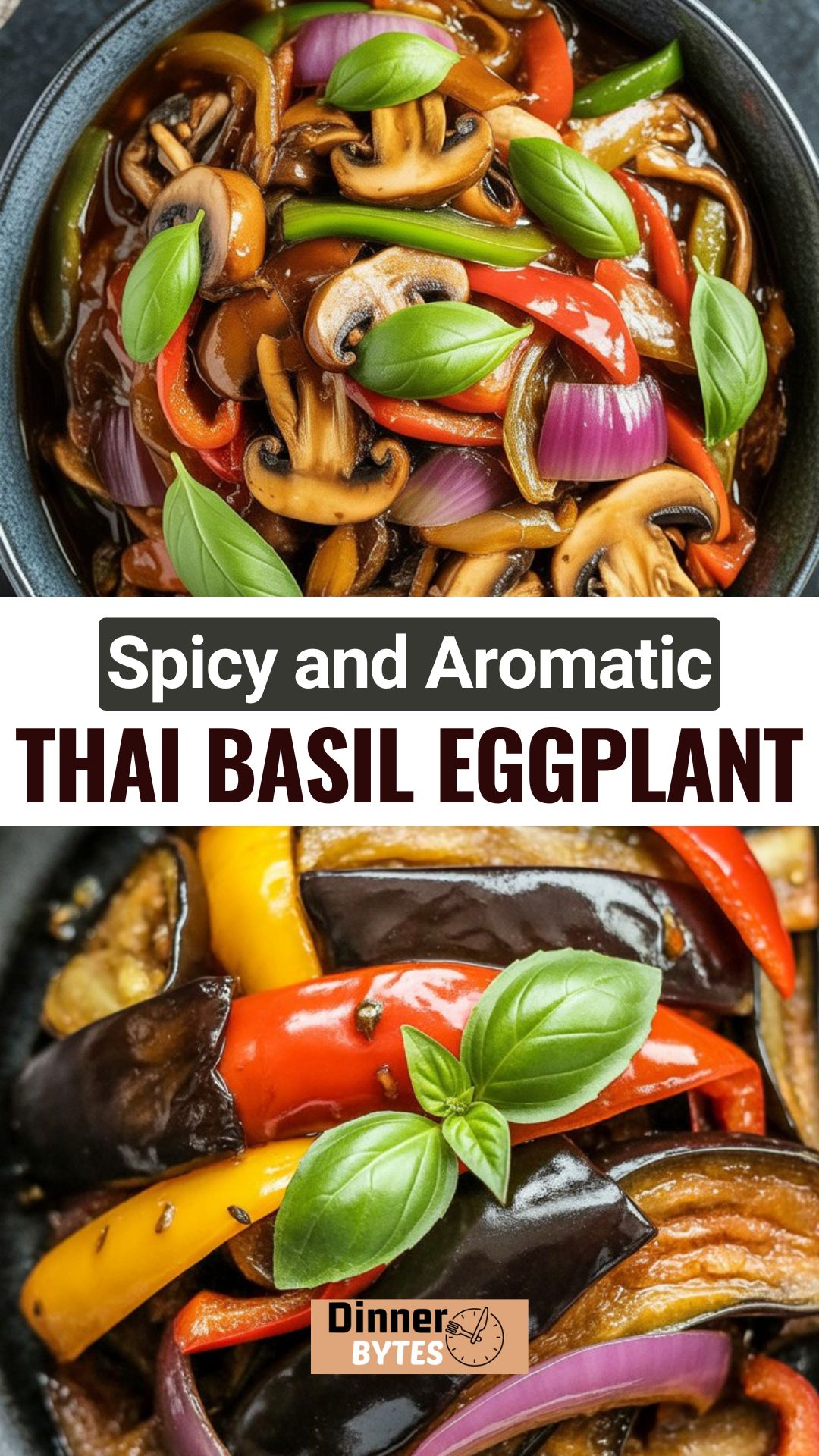
Leftovers and Storage
This keeps really well in the fridge for up to 3 days. The flavors deepen overnight, which I secretly love. Just reheat gently on the stove or in the microwave. If it feels too thick, a splash of water or broth will loosen it up.
Common Questions
Can I use regular eggplant?
You can, but the texture won’t be quite the same. If that’s all you have, try peeling some of the skin and slice it thin so it softens properly.
What can I use instead of Thai basil?
Honestly, nothing really replicates it. But if you’re in a pinch, a mix of sweet basil and a little mint can get you close.
Can I bake the eggplant instead?
You can! Brush with oil and roast at 400°F until soft and golden. Then toss with the sauce and veggies as usual.
Is this kid-friendly?
Yes—just reduce or skip the chili and sriracha. The sauce is still flavorful without the heat.
Thai Basil Eggplant
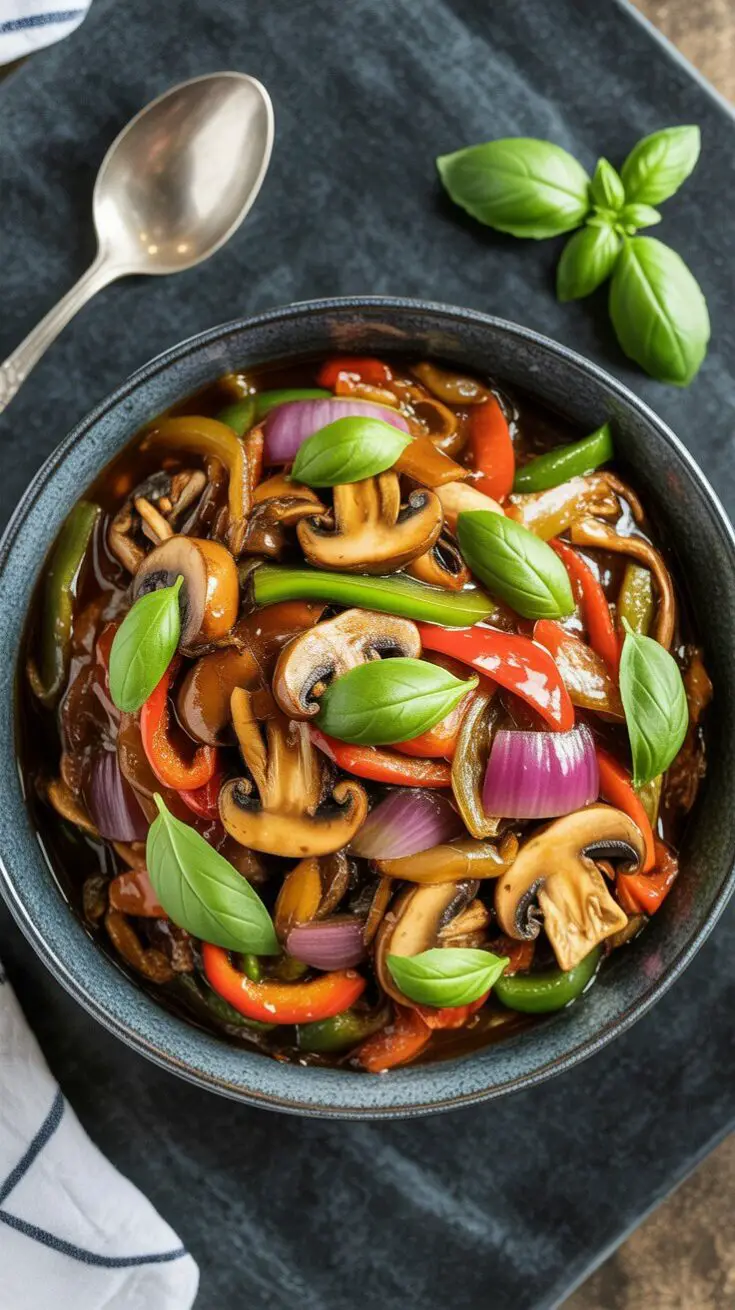
This Thai Basil Eggplant is a weeknight favorite in my kitchen—tender slices of eggplant pan-seared and tossed in a bold, slightly sweet sauce with a little heat. It's completely plant-based, naturally gluten-free, and pairs beautifully with jasmine rice or noodles for a cozy meal.
Ingredients
For the Sauce:
- 3 tablespoons tamari (or soy sauce)
- 2.5 tablespoons maple syrup
- 2 tablespoons rice vinegar
- 1–2 teaspoons sriracha, to taste
- 1 tablespoon peanut butter
- 1 teaspoon toasted sesame oil
- A pinch of ground cinnamon
- A pinch of ground coriander
- 1/3 cup water
Cornstarch slurry:
- 2 teaspoons cornstarch
- 2 tablespoons water
For the Stir-Fry:
- 2 medium Japanese eggplants, sliced into thick half-moons
- 1/2 large red bell pepper, sliced
- 1/2 large green bell pepper, sliced
- 1/2 medium white onion, sliced
- 5–6 garlic cloves, chopped
- 1.5-inch piece of fresh ginger, chopped
- 1 Thai green chili, thinly sliced
- 1/2 cup Thai basil leaves, roughly chopped
- 4 tablespoons oil (divided; avocado oil works well)
- Salt, to taste
Instructions
- Start by prepping the vegetables—slice the eggplant into thick pieces (not too thin, or they’ll fall apart), and chop the peppers and onion. Set them aside.
- Next, combine all the sauce ingredients in a blender—tamari, maple syrup, rice vinegar, peanut butter, sriracha, sesame oil, cinnamon, coriander, and water. Blend until smooth and set the sauce aside. Mix the cornstarch with water in a separate small bowl and keep it ready.
- Heat a tablespoon of oil in a large skillet over medium-high heat. Add the bell peppers and onion and sauté for just 1–2 minutes until slightly blistered but still crisp. Transfer to a plate lined with paper towels.
- Now, add 2 tablespoons of oil to the same pan and arrange the eggplant in a single layer. Cook over medium heat, stirring every now and then and sprinkling just a touch of water to help them soften. Depending on your pan size, you may need to do this in two batches. Cook until the eggplant is golden and fork-tender—about 7–8 minutes total. Set aside on a plate.
- In the same pan (or a clean one), heat the last tablespoon of oil. Add chopped garlic, ginger, and Thai chili. Sauté for a minute or so until fragrant and lightly golden.
- Pour in the blended sauce and give the cornstarch slurry a quick stir before adding that too. Turn the heat up to bring the sauce to a simmer—it’ll thicken in just a couple of minutes.
- Toss the cooked eggplant, peppers, and onion back into the pan. Add the Thai basil and gently mix until everything is coated in that glossy, flavorful sauce. Let it all simmer together for another minute or two. Taste and season with a little salt if needed.
- Serve hot, topped with a few extra basil leaves. It’s delicious over steamed rice or even rice noodles.
Notes
- If the sauce tastes peanut-heavy at first, don’t worry—it mellows out perfectly once it hits the heat and mixes with the veggies.
- Japanese eggplants are ideal here—they cook faster and hold their shape better than larger varieties.
Nutrition Information
Yield
4Serving Size
1Amount Per Serving Calories 405Total Fat 18gSaturated Fat 2gTrans Fat 0gUnsaturated Fat 15gCholesterol 0mgSodium 1348mgCarbohydrates 58gFiber 10gSugar 23gProtein 8g
dinnerbytes.com, occasionally offers nutritional information for recipes contained on this site. This information is provided as a courtesy and is an estimate only. This information comes from online calculators. Although dinnerbytes.com attempts to provide accurate nutritional information, these figures are only estimates.
Final Thoughts
This Thai Basil Eggplant has become one of those comfort meals I turn to when I want something full of flavor but don’t want to be stuck in the kitchen all evening. It’s bold, satisfying, and just a little addictive. If you’ve got some eggplants lying around, give this one a try—you might just find a new favorite.
Try other Eggplant Recipes:


